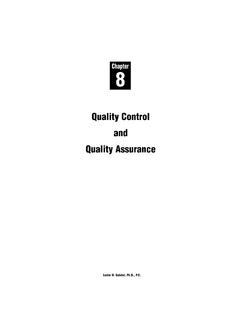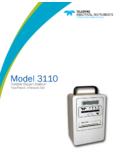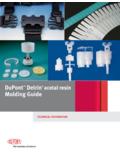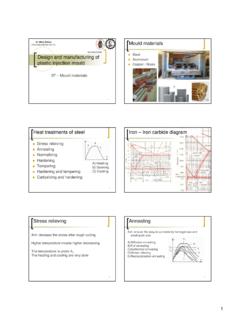Transcription of Designing with engineering Plastics
1 2x45 30+0,520+0,5 70,05+0,1 50,05+0,12 682x45 Designing with engineering PlasticsTitel Konstruieren 10:19 Uhr Seite 1 Licharz on the web Certified quality management according to DIN EN ISO 9001 : 2000 DIN EN ISO 9001:2000 Certificate No 01 100 040034 Konstr. Kunststoffe 7:32 Uhr Seite 2 TolerancesKonstr. Kunststoffe 7:40 Uhr Seite tolerances for machined plastic construction partsPlastics are often integrated into existing assemblies to replace conventional materials. As a rule,however, the production drawing is only altered in respect to the new material. Often the tolerances that have been specified for the steel component are not adapted to suit the new material. But even in the case of new designs where plastic is planned as a material, the tolerancefields that are normal for steel are still , the special features of Plastics extensively preclude the choice of the narrow productiontolerances required for steel decisive factor is not the possibility of manufacturing the parts, since this is virtually no problem with the use of modern CNC machine tools, but rather the permanent compliance withthe tolerances after the manufacturing process.
2 This applies especially to dimensions in a class oftolerances with very narrow fields (< ). These can change immediately after the part is taken from the machine table due to the visco-elastic behaviour of the Plastics . In particular, thehigher level of thermal expansion, volume changes due to the absorption of moisture as well asform and dimensional changes caused by the relaxation of production-related residual stressesare just some of the possible problem is the fact that there is no general standard for machined plastic lack of a common basis for material-related tolerance for parts such as this often leads to disagreement between the customer and the supplier in regard to the classification of rejectsand/or defects in delivery. Choosing a tolerance field that is suitable for the respective materialcan avoid disputes and also ensure that the plastic components function and operate safely as following sections of this chapter are based on our many years of experience with differentplastics and are intended to assist design engineers in defining tolerances.
3 The aim is to create astandard basis and to avoid unnecessary costs caused by rejects due to off-spec tolerance fields that we recommend can be achieved with conventional production methodsand without any additional expenditure. In general, the functioning and operating safety of thecomponents were not limited because of the increased tolerance. Narrower tolerances than thosestated here are possible to a certain extent, but would necessitate unjustifiably high processingexpenditure, and the materials would also require intermediate treatment (annealing) during theproduction process. If component parts require tolerance fields of < or ISO series IT 9 fitsand smaller, we will be happy to advise you in the choice of a technically/economically practicaland sustainable tolerance tolerancesThe general tolerances for untoleranced dimensions can be chosen according to DIN ISO 2768 T1,tolerance class m.
4 In this standard, the tolerances are defined as follows:Konstr. Kunststoffe 7:40 Uhr Seite 1065 TolerancesTable 1: Limiting dimensions in mm for linear measures (DIN ISO 2768 T1)Nominal size range in mmTolerance0,5above 3above 6classup to 3up to 6f (fine)m (medium) 0,2 0,5 1,0g (rough)v (very rough) 0,4 1,0 2,0 Nominal size range in mmTolerance0,5above 3above 6above 30above 120above 400 above 1000 above 2000classup to 3up to 6up to 30up to 120up to 400up to 1000 up to 2000 up to 4000f (fine) 0,05 0,05 0,1 0,15 0,2 0,3 0,5-m (medium) 0,1 0,1 0,2 0,3 0,5 0,8 1,2 2,0g (rough) 0,15 0,2 0,5 0,8 1,2 2,0 3,0 4,0v (very rough) - 0,5 1,0 1,5 2,5 4,0 6,0 8,0 Table 2: Limiting dimensions in mm for radius of curvature and height of bevel (DIN ISO 2768 T1)Table 3: Limiting dimensions in degrees for angle measurements (DIN ISO 2768 T1)Nominal size range of the shorter leg in mmToleranceup to 10above 10above 50above 120above 400classup to 50up to 120up to 400f (fine) 1 30 20 10 5 m (medium)g (rough) 1 30 1 30 15 10 v (very rough) 3 2 1 30 20 In special cases, for longitudinal dimensions it is possible to choose the tolerance class f.
5 However, it is important that permanent compliance with the tolerance in regard to componentgeometry is checked in agreement with the and positionThe general tolerances for untoleranced dimensions can be selected according to DIN ISO 2768 T2,tolerance class K .In this standard the tolerances are defined as follows:Table 4: General tolerances for straightness and evenness (DIN ISO 2768 T2)Nominal size range in mmToleranceabove 10above 30above 100above 300above 1000classup to 10up to 30up to 100up to 300up to 1000up to 3000H0,020,050,10,20,30,4K0,050,10,20,40 ,60,8L0,10,20,40,81,21,6 Konstr. Kunststoffe 7:40 Uhr Seite 1076 TolerancesDimension categoryPlasticsCommentsAPOM, PET, PTFE+glass, PTFE+bronze,Thermoplastics with or PTFE+coal,PC,PVC-U, PVDF, PP-H, or without reinforcement/PEEK, PEI, PSU, HGW (laminated fillers fabric)( with low moisture absorption)BPE-HD, PE-HMW, PE-UHMW, PTFE,Soft thermoplastics and PA 6, PA 6 G, PA 66, PA 12polyamides with moisture absorptionTable 5: General tolerances for rectangularity (DIN ISO 2768 T2)Nominal size range in mmToleranceabove 100above 300above 1000classup to 100up to 300up to 1000up to 3000H0,20,30,40,5K0,40,60,81,0L0,61,01,5 2,0 Nominal size range in mmToleranceabove 100above 300above 1000classup to 100up to 300up to 1000up to 3000H0,5K0,60,81,0L0,61,01,52,0 Table 6.
6 General tolerances for symmetry (DIN ISO 2768 T2)The general tolerance for run-out and concentricity for class K is special cases for shape and position it is possible to choose tolerance class H . The general tolerance for run-out and concentricity for class H is , it is important that permanent compliance with the tolerance in regard to componentgeometry is checked in agreement with the described above, it is not possible to apply the ISO tolerance system that is usually applied tosteel components. Accordingly, the tolerance series IT 01 9 should not be used. In addition, todetermine the correct tolerance series, the processing method and the type of plastic being usedmust be Dimensional categoriesThe different Plastics can be classified into two categories according to their dimensional are shown in Table 7: Dimension categories for plasticsKonstr.
7 Kunststoffe 7:40 Uhr Seite Classification of tolerance series for milled partsClassification for milled parts with tolerancesDimension AIT 10 - 12category:BIT 11 - 13 Table 8: ISO basic tolerances in m according to DIN ISO 286 Nominal size ISO tolerance series (IT)range in mm 678910111213141516 From up to1-361014254060100140250400600 Above up to 3-681218304875120180300480750 Above up to 6-1091522365890150220360580900 Above up to 10-1811182743701101802704307001100 Above up to 18-3013213352841302103305208401300 Above up to 30-501625396210016025039062010001600 Above up to 50-801930467412019030046074012001900 Above up to 80-1202235548714022035054087014002200 Above up to 120-180254063100160250400630100016002500 Above up to 180-250294672115185290460720115018502900 Above up to 250-315325281130210320520810130021003200 Above up to 315-400365789140230360570890140023003600 Above up to Classification of tolerance series for turned partsClassification for turned parts with tolerancesDimensionAIT 10 - 11category:BIT 11 - 12 Table 8.
8 ISO basic tolerances in m according to DIN ISO 286 Nominal size ISO tolerance series (IT)range in mm 678910111213141516 From up to1-361014254060100140250400600 Above up to 3-681218304875120180300480750 Above up to 6-1091522365890150220360580900 Above up to 10-1811182743701101802704307001100 Above up to 18-3013213352841302103305208401300 Above up to 30-501625396210016025039062010001600 Above up to 50-801930467412019030046074012001900 Above up to 80-1202235548714022035054087014002200 Above up to 120-180254063100160250400630100016002500 Above up to 180-250294672115185290460720115018502900 Above up to 250-315325281130210320520810130021003200 Above up to 315-400365789140230360570890140023003600 Above up to 400-500406397155250400630970155025004000 Konstr. Kunststoffe 7:40 Uhr Seite qualityThe degree of surface quality that can be achieved depends on the processing method.
9 Table 9shows the surface qualities that can be achieved without any additional expenditure for the indi-vidual 9: Achievable surface qualities for various machining processesForm of machiningMax. achievable Average roughness Averaged depth of degree of roughnessvalue Ra( m)roughness Rz( m)MillingN71,68 TurningN71,68 PlaningN83,212,5 SawingN83,216It is possible to achieve better surface qualities than those shown in Table 9 in conjunction withhigher production expenditure. However, the production possibilities must be discussed with themanufacturer of the component part in regard to the respective plastic and the processing for press Oversize for bushesTo ensure that friction bearing bushes sit properly in thebearing bore, the insertion of an oversized componenthas proved to be good method. The oversize for plastic bushes is very large compared to metal bearingbushes.
10 However, due to the visco-elastic behaviour ofthe Plastics , this is especially important because of theeffects of heat, as otherwise the bearing bush would become loose in the bore. If the maximum service tem-perature is 50 C, it is possible to do without an additi-onal securing device for the bearing bush if the oversizesfrom Diagram 1 are complied with . In the case of tem-peratures above 50 C, we recommend that the bush besecured with a device commonly used in machine en-gineering ( a retaining ring according to DIN 472, seealso the chapter on Friction bearings section ).It should also be considered that when the bearingbush is being inserted, its oversize leads to it beingcompressed. Consequently the oversize must beconsidered as an excess to the operating bearingplay, and the internal diameter of the bearingmust be dimensioned accordingly. Diagram 2 shows the required bearing play in relation to theinternal diameter of the bearing.










